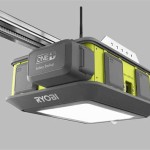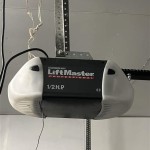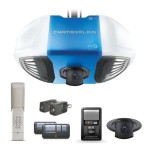Battery Backup Garage Door Openers: Ensuring Access During Power Outages
Garage door openers have become a standard feature in modern homes, offering convenience and security. However, their reliance on electricity can become a significant problem during power outages. A battery backup garage door opener provides a solution to this issue, ensuring that residents can still access their garage, and by extension, their homes, even when the main power supply is interrupted. This article will delve into the workings, benefits, installation, maintenance, and factors to consider when selecting a battery backup garage door opener.
The primary function of a garage door opener is to automate the opening and closing of the garage door. Traditional models are directly powered by the home's electrical system. When the power goes out, these openers become inoperable, potentially trapping vehicles inside or preventing access to the garage altogether. Battery backup openers mitigate this problem by incorporating a rechargeable battery that automatically takes over when the primary power source fails. This ensures continuous operation, albeit with limited uses on battery power alone.
Understanding the Mechanism of Battery Backup Systems
The key component of a battery backup garage door opener is, naturally, the battery itself. These are typically sealed lead-acid or lithium-ion batteries designed to provide enough power to operate the garage door several times during an outage. The battery remains in a charging state under normal circumstances, constantly replenished by the main power supply. A monitoring system within the opener detects power failures and seamlessly switches over to battery power, allowing the user to operate the door using the remote control, wall-mounted button, or keypad, just as they would during normal operation.
The complexity of the system extends beyond just the battery and the motor. A crucial element is the charging circuit, which regulates the charging process to prevent overcharging or undercharging, both of which can significantly reduce the battery's lifespan. Sophisticated models often include a battery monitoring feature that provides information about the battery's charge level and overall health, alerting the user when replacement is necessary. Furthermore, these systems often incorporate surge protection to safeguard the electronics from power surges that can occur when the electricity is restored.
The operational range of a battery backup opener on battery power depends on factors such as the battery's capacity, the weight and condition of the garage door, and the frequency of use. Most manufacturers provide an estimated number of open/close cycles the battery can support before it is depleted. It's essential to understand these limitations and to avoid excessive use during power outages to conserve battery power for critical situations.
Safety features remain fully functional even when operating on battery power. These include obstruction detection systems that prevent the door from closing if an object or person is in its path and safety sensors located near the floor that use an infrared beam to detect obstructions. These safety features are crucial for preventing accidents and injuries, regardless of the power source.
Benefits of Installing a Battery Backup Garage Door Opener
The most obvious benefit is uninterrupted access to the garage during power outages. This can be incredibly important for individuals who rely on their garage for parking their vehicles or who need to access their homes through the garage. In emergency situations, such as a fire or medical emergency, the ability to quickly exit the garage can be life-saving.
Security is another significant advantage. A garage door is often a vulnerable point of entry into a home. During a power outage, a standard garage door opener becomes useless, potentially leaving the garage door unsecured. A battery backup system ensures that the door remains functional and secure, preventing unauthorized access to the property. This peace of mind is invaluable, especially during severe weather events that often lead to power outages.
Convenience is also a key factor. Imagine arriving home during a storm only to find that the power is out. Without a battery backup, manually lifting the heavy garage door can be difficult and inconvenient, especially for elderly or disabled individuals. A battery backup opener eliminates this problem, allowing for effortless operation regardless of the power situation.
Moreover, some insurance companies may offer discounts on homeowner's insurance for properties equipped with security features like battery backup garage door openers. While the specific discount amount will vary depending on the insurer and location, it's worth investigating this potential cost-saving benefit.
Factors to Consider When Choosing a Battery Backup Garage Door Opener
Several factors should be taken into account when selecting a battery backup garage door opener to ensure it meets individual needs and preferences. First, consider the power of the opener. Garage door openers are classified by horsepower (HP), with heavier doors requiring more powerful openers. A ½ HP opener is typically sufficient for standard single-car garage doors, while a ¾ HP opener is recommended for heavier doors or double-car garages. Choosing an opener with adequate power ensures smooth and reliable operation, especially when running on battery power.
The type of drive system is another important consideration. Common drive systems include chain drive, belt drive, and screw drive. Chain drive openers are the most affordable but also the loudest. Belt drive openers are quieter and require less maintenance, making them a popular choice for homes with attached garages. Screw drive openers are durable and reliable but can be sensitive to temperature changes. The best choice depends on factors such as budget, noise sensitivity, and climate.
Battery capacity is a critical factor to evaluate. Different models offer varying battery capacities, which directly affects the number of open/close cycles the opener can perform during a power outage. Consider the frequency with which the garage door is typically used and the likelihood of extended power outages in the area. Opting for a model with a higher battery capacity provides greater peace of mind and reduces the risk of being stranded during prolonged outages.
Smart features are increasingly common in modern garage door openers. These features allow users to control and monitor the opener remotely via a smartphone app. This can be particularly useful during power outages, as it allows users to check the status of the door and operate it remotely, even if they are not physically present. Some smart openers also integrate with other smart home systems, allowing for seamless automation and control.
Safety features are paramount. Look for openers that include obstruction detection systems and safety sensors that comply with current safety standards. These features are essential for preventing accidents and injuries, and they should be fully functional even when the opener is operating on battery power.
Finally, consider the warranty offered by the manufacturer. A longer warranty period indicates greater confidence in the product's quality and durability. Pay attention to the specific components covered by the warranty, such as the motor, battery, and electronics. A comprehensive warranty provides added protection against defects and malfunctions.
Installation and Maintenance of Battery Backup Garage Door Openers
Installation of a battery backup garage door opener is generally similar to that of a standard opener. However, it's crucial to follow the manufacturer's instructions carefully to ensure proper installation and operation. If unsure, consider hiring a professional installer to avoid potential safety hazards and ensure that the system is installed correctly.
The first step is to disconnect the power supply to the existing opener. Then, remove the old opener and any associated hardware. Next, install the new opener according to the manufacturer's instructions, ensuring that all components are properly aligned and securely fastened. Connect the safety sensors and obstruction detection system, and test them thoroughly to ensure they are working correctly. Finally, connect the opener to the power supply and program the remote controls and keypad.
Maintenance is essential for ensuring the long-term reliability and performance of the battery backup system. Regularly inspect the battery for signs of damage or corrosion. Clean the battery terminals as needed to ensure good contact. Check the battery's charge level periodically to ensure it is fully charged. If the battery's performance deteriorates significantly, replace it with a new battery of the same type and voltage.
Additionally, periodically inspect the garage door itself for any signs of wear or damage. Lubricate the moving parts, such as the hinges and rollers, to ensure smooth operation. If the door is difficult to open or close, it may indicate a problem with the springs or tracks. In such cases, it's best to consult a professional garage door technician for assistance.
Regularly test the battery backup system by disconnecting the power to the opener and verifying that it switches over to battery power seamlessly. This will ensure that the system is functioning correctly and that the battery is capable of providing sufficient power to operate the door. If the system fails to switch over to battery power, consult the manufacturer's troubleshooting guide or contact a qualified technician for assistance.
Proper disposal of the old battery is crucial for environmental reasons. Sealed lead-acid and lithium-ion batteries contain hazardous materials that can contaminate the environment if not disposed of properly. Most battery retailers and recycling centers offer battery recycling programs. Follow the local regulations for proper battery disposal.
By understanding the workings, benefits, selection criteria, installation, and maintenance of battery backup garage door openers, homeowners can make informed decisions and ensure that they have a reliable and secure solution for accessing their garages during power outages. This preparedness provides not only convenience but also essential security and safety for the home and its occupants.

Genie 140 Volt Motor Garage Door Opener Battery Backup 41590r

041b0591 Battery Backup Kit Parts Chamberlain

Genie Signature Series 1 4 Hpc Ultra Quiet Belt Drive Garage Door Opener With Battery Backup 7055d Tksv

Chamberlain 0 75 Hp Myq Battery Backup Belt Garage Door Opener At Lowes Com

Chamberlain B4613t Belt Drive Smart Garage Door Opener 3 4 Hp

Genie 140 Volt Motor Garage Door Opener Battery Backup 41590r

Genie 140 Volt Motor Garage Door Opener Battery Backup 41590r

B4655t Secure View Camera Wi Fi Battery Backup Garage Door Opener Chamberlain

Battery Backup 24v Go Merlin

Liftmaster Belt Drive 87504 Secure View Ultra Quiet Smart Opener With Camera Led Corner To Lighting And Battery Backup








